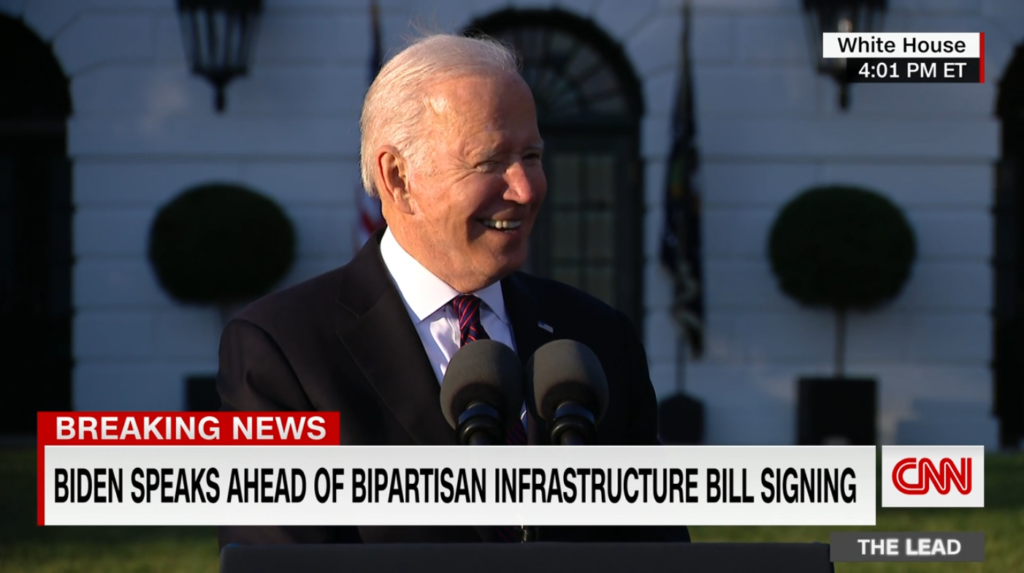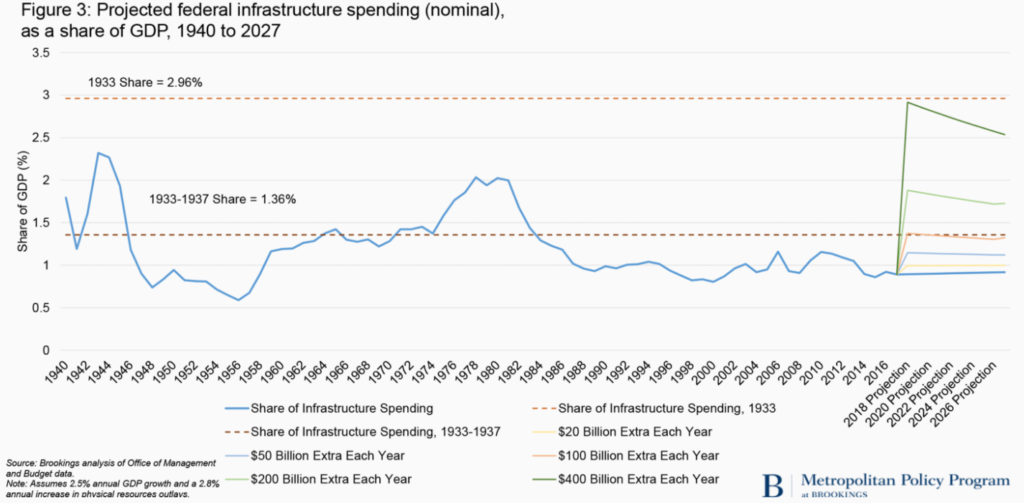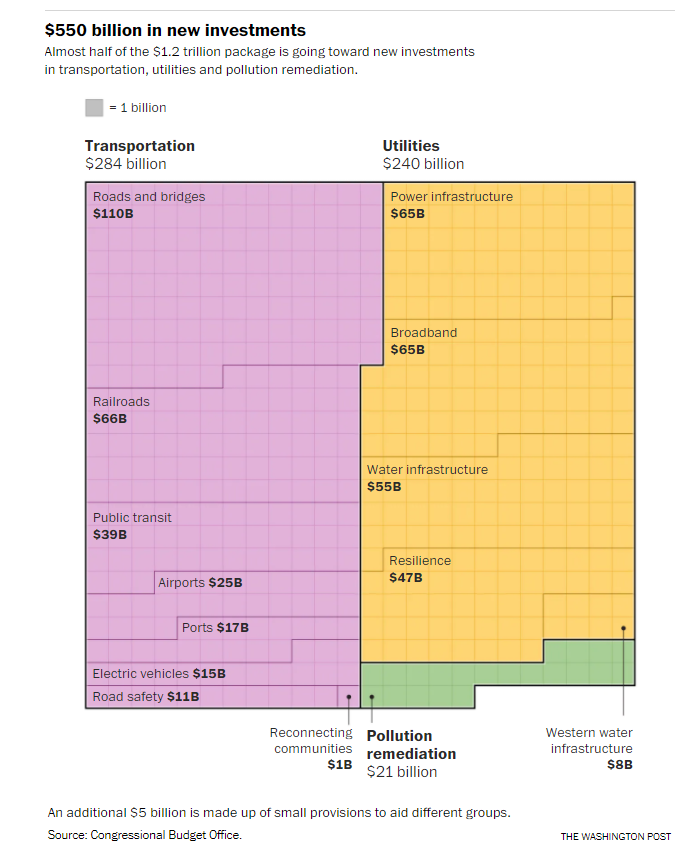Conventional “wisdom” from the chattering classes naysayed what is happening today as an impossibility or dead again and again, with such “wisdom” driving the media’s pathetic coverage of the biggest legislative story coming out of Washington in a half-century. Some serious perspective is in order.
By Brian E. Frydenborg (LinkedIn, Facebook, Twitter @bfry1981) Novermber 15, 2021

SILVER SPRING—He was mocked, again and again, for believing bipartisanship was possible, on the campaign trail and since becoming president. Even more so for believing he could achieve this as a supposedly out-of-touch old white male. Many pundits on CNN joined the young, woke reporters and columnists on the political beat for the New York Times and Washington Post throughout the primaries, general election, and into the Biden presidency, much in line with their editorial boards and the same folks at many other mainstream publications. For the far-left media and writers, Joe Biden was like a Republican and a relic from a bygone area that “just didn’t get it;” for the far-right, Biden has been some sort of combination of senile and socialist.
And yet, here he is despite the media thinking he was old news in early 2020: his infrastructure bill—formally titled the Infrastructure Investment and Jobs Act (IIJA)—passed the U.S. Senate with nineteen Republicans votes (and all fifty Democrats) and, more recently, the U.S. House with thirteen Republican votes and is moments away from being signed by now-President Biden into law.
To quote the current president when he was vice president to Barack Obama from the signing of Obamacare/ACA (Affordable Care Act) into law: “This is a big fucking deal!” (BFD)
Some of the Republican House votes were necessary because the six most far-left members of the House, together known as the “The Squad,” just had to stand out and not be team players even on such a historic bill: the original four of Reps. Alexandria Ocasio-Cortez (NY), Ilhan Omar (MN), Rashida Tlaib (MI), and Ayanna Pressley (MA), with the two newcomers Jamaal Bowman (NY) and Cori Bush (MO), some of the loudest, harshest, and most consistent critics of Biden from the left. Having fought in good faith to get more in the bill after a months-long campaign and/or get a vote on Biden’s social spending Build Back Better bill first, in the end, they preferred signaling the lack of dissatisfaction with the scale of the historic $1.2-trillion bill and/or the process than being part of a massive leap forward for their party, the Biden Administration, and all Americans regardless of their party affiliation or ideology (as a result, they are hearing complaints from plenty of their constituents). They voted contrary to 89 of 95 members in their own House Progressive Caucus, including their leader, Rep. Pramila Jayapal (WA).
As much as we should be dissatisfied with those six renegade Democrats, we should be far more upset that most Republicans in the Senate and the vast majority of House Republicans voted against it. Along with the six House Democrats, they were, in the end, spectators to History with a capital “H,” and the overall differences between the two parties could not be clearer when looking at the details of what is the bill, what the vast majority of Republicans in Congress opposed and the vast majority of Democrats supported…
And that is the biggest investment in national infrastructure in more than a generation.
Out of $1.2 trillion in the bill, almost half—$550 billion—is new spending over the next five years that would be above what we would be spending on infrastructure in an “all things being equal,” or what policy wonks would call a “baseline,” sense (the spending under the currently enacted budget and laws, essentially what we would spend if the exact same budget and spending levels were authorized again but adjusted for inflation, an estimate provided by the non-partisan Legislative Branch agency called the Congressional Budget Office, your fine government professional bureaucrats at work and I mean that in a non-facetious way!). Of course, that is never guaranteed—cuts can always be made, so not only does Biden’s infrastructure bill keep the current baseline, it nearly doubles it, adding an average of $110 billion more in spending each year for the next five years. But the Democrats’ agenda will almost certainly do even more than that: the House reconciliation budget bill, a big part of Biden’s Build Back Better agenda, is going to include a lot more infrastructure spending, too, and those parts are not likely the parts that conservative Democratic Senators Joe Manchin (WV) and Kyrsten Sinema (AZ) might force out or pare down, meaning there could (and likely will be) be an additional $500 billion in new non-baseline infrastructure spending over ten years, or an average of an additional $50 billion a year; that would mean that, for the next five years, we would be seeing an average of $160 billion above baseline per year.
Ok, so there are some relative numbers for you, but what does that mean? Well, to answer that, we need history.

In a historical sense, this truly is a once-in-a-generation investment in America’s future. You have to go back more than four decades, to the 1970s, when anything like this kind of infrastructure spending was happening at the same or higher a percentage of our GDP (adjusted for inflation), and it would exceed the levels of the Franklin Delano Roosevelt’s New Deal-era infrastructure spending from 1933-1937. In the past century, only during World War II and the 1970s have we spent more on infrastructure over a period of several years, then, than we would be going forward under president Joe Biden (and we really don’t have the same quality of analysis for earlier investments, such as the effort begun under Abraham Lincoln—even in the midst of the Civil War—to forge a transcontinental railroad, so this really could be among the biggest relative investments in infrastructure in American history; even without the extra $50 billion a year from the reconciliation Build Back Better bill, it would still be by far the largest infrastructure spending over several years in roughly the last half-century, even if it would be at lower GDP levels than the New Deal).

We know what a huge impact these spending sprees had: under FDR, we brought America into the modern world, and in the Nixon/Carter era, well, there’s a good chance that road or bridge you are driving on today was shored up to much of its present state or built in that era, or that rehabilitating your water utilities and making polluted water safe for use again also happened then. Those eras cover most of the highways we use and much of the electric grid we have, especially if you live in rural America (Tennessee Valley Authority, anyone?).
I don’t know about you, but I’ve been abroad repeatedly in the past two decades, and I can tell you our infrastructure is mostly either creaking and/or outdated compared to much of the rest of the world. The American Society of Civil Engineers (ASCE) even rated our overall infrastructure as a C- in its latest report.
Some facts to consider: about one-fifth of students did not have high-speed internet for their classes during last year’s COVID-19 lockdowns; we lose six billion gallons of treated water every day from water main ruptures; some 42% of our bridges are at least 50 years old; some 43% of our roads are in a middling or bad state. This bill’s investments are not only necessary, but long overdue. And, after roughly a half-century of nothing comparable, help is finally coming.

Specifically, there is:
- $110 billion for new bridges/roads
- $73 billion for shifting away from fossil fuels towards green energy and upgrading the power grid
- $66 billion for Amtrak/rail
- $65 billion for high-speed internet, especially underserved rural areas
- $55 billion to remove/replace lead from our water system and for clean drinking water
- $50 billion for adding weather-, climate-change-, and cyberattack-resiliency to our infrastructure
- $39 billion in new public transportation funding and to improve its accessibility for disabled and older Americans
- $25 billion for airports
- $21 billion in environmental cleanup
- $17 billion for ports
- $15 billion for electric vehicles/chargers
- $11 billion reducing car crashes and improving safety for cyclists and pedestrians
- $8 billion to aid Western states wracked by drought and wildfires to develop their water systems
- $1 billion to address past racist infrastructure planning/implementation

We are still living in an America creaking forward some forty-to-ninety-years after these massive investments of the past; just imagine what people will be saying decades in the future because of the legacy these Biden bills will have left for a generation not even yet born. This is one of the only non-defense long-term investments I’ve seen our government make in my lifetime. And these are not esoteric, special-interest investments that will not reach most Americans or sit unused because of confusion or bureaucracy: every single person in the country that will be alive in a few years and every single person that will be born for decades to come will literally live, breathe, drink, web-browse, and/or traverse the effects of this bill. Even if you, say, already have broadband internet or clean drinking water, you will still see the improvements in roads and airports. Not a driver? Public transportation and pollution alleviation will hit you instead. Even the more “specialized” projects, like Western state water infrastructure development and Amtrak—will still affect tens of millions of Americans. And all of these benefits will greatly enhance our economy and quality of life: faster transit of people, goods, and services; less loss of work and life due to preventable diseases caused by pollution and improvement in transportation safety; students in rural America learning better with better internet connections and becoming more productive members of society; enormous savings in not having to maintain dilapidated power grids and bridges that will free up funds for all manner of programs benefitting millions in ways not yet considered.
And yet, even as I write this, CNN led with the Kyle Rittenhouse trial and spent more or as much time talking about supposed friction between Biden’s and Harris’s staff (staff, not the President and VP themselves) and Adele’s interview with Oprah. In the hours after the bill finally passed the House last week, the trampling tragedy at a Houston concert was the lead story for days. The New York Times, Washington Post, and L.A. Times this morning lacked any large-font, prominently-placed stories on their homepages on this bill.
As I have lamented repeatedly, the mainstream media has been myopic when it comes to prioritizing and weighting some of the biggest stories (and non-stories) of the past half-decade, from Hillary’s much-ado-about-little e-mails and then-FBI Director James Comey’s ill-timed “reopening” of that to the massive Trump-Russia saga as well as coverage of hunter Biden and Trump-Ukraine (really, as I noted in depth, another phase of Trump-Russia).
Now, in 20201, this lack of extended, deep, and lasting coverage of this infrastructure bill—the bill itself, not the he-said, she-said negotiations of the abysmal horse-race process coverage—and the lack of attention and weight given to it once its form was final, makes this bill the most miscovered, underreported story of 2021. The media has done an admirable job of covering the momentousness and weight of the Trump Capitol insurrection, of keeping attention focused on it when it should be. But to the degree it has done an excellent job of that, it has done a terrible job of covering and weighting Biden’s Infrastructure Investment and Jobs Act. I get that there is a tendency to focus on the negative and personalities, but here is something grand, substantive, and institutional, and all the media can do it whiff. So if the major media outlets think it is too boring to focus on the details of this once-in-generation investment in infrastructure and the impact it will have on all of us and our nation for decades to come, I am happy to do so in their stead.
© 2021 Brian E. Frydenborg all rights reserved, permission required for republication, attributed quotations welcome
See related article The Kabul Airlift in Light of the Berlin Airlift: Surprising Parallels and Important Lessons
Also see my eBook, A Song of Gas and Politics: How Ukraine Is at the Center of Trump-Russia, or, Ukrainegate: A “New” Phase in the Trump-Russia Saga Made from Recycled Materials, available for Amazon Kindle and Barnes & Noble Nook (preview here), and be sure to check out Brian’s new podcast!

If you appreciate Brian’s unique content, you can support him and his work by donating here
Feel free to share and repost this article on LinkedIn, Facebook, and Twitter. If you think your site or another would be a good place for this or would like to have Brian generate content for you, your site, or your organization, please do not hesitate to reach out to him!